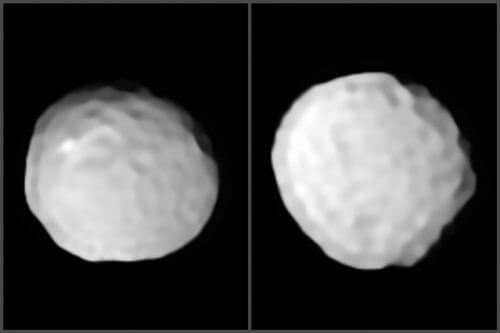Recently, telescopic observations revealed its surface for the first time. Although the photographs are of very low resolution, you can get preliminary information about its appearance and basic knowledge about its topography

In a study published in the journal Nature Astronomy, researchers reveal detailed images of Pallas, revealing its cratered surface for the first time. Dozens of researchers from 21 research institutions around the world are participating in the research.
Pallas's trajectory suggests very fast impacts," says Michael Mercest, the paper's lead author and a postdoctoral fellow in MIT's Department of Earth, Atmospheric, and Planetary Sciences. "From these images we can now say that Pallas is the most cratering object we know of in the asteroid belt. It's like discovering a new world."
"violent history"
The team, led by principal investigator Pierre Veranza of the Laboratoire d'Astrophyisque de Marseille in France, photographed Pallas using the SPHERE instrument on the European Observatory's Largest Telescope (VLT) - an array of four telescopes, each with an eight-meter-wide mirror , located in the mountains of Chile. In 2017, and again in 2019, Mercest and his colleagues occupied one of the four telescopes for several days at a time to see if they could capture images of Pallas at the point in its closest orbit to Earth.
The team took 11 sets of images in the two observations and were able to see Pallas from different angles as it rotated on its axis. After processing the images, the researchers created a three-dimensional reconstruction of the asteroid's shape, with a map of craters at the poles and parts of its equatorial region.
In total, they identified 36 craters that grew to a diameter of more than 30 km - about a fifth of the diameter of the Earth's Chicxulub crater, whose impact apparently caused the extinction of the dinosaurs 65 million years ago. Pallas' craters appear to cover at least ten percent of the asteroid's surface, "suggesting a violent collision history," as the researchers state in the study.
During the observations, the researchers were able to discover two more additional formations - a bright spot in the southern hemisphere of the asteroid as well as a huge impact crater along the asteroid's equator with a diameter of about 400 km.
The Pallas asteroid (numbered 2 according to the order of its discovery) was discovered in 1802, its dimensions are 550 × 476 × 516 km, its distance from the Sun is 2.7 astronomical units. It circles it once every 4.62 earthly years and its day is 7.81 hours long. Its density is 2.8. Recently through telescopic observations revealed its surface for the first time. Although the photographs are of very low resolution, you can get preliminary information about its appearance and basic knowledge about its topography.
In terms of size, it can also be considered a dwarf planet, a body with an almost spherical structure, it is likely that its internal structure is similar to that of the inner planets, core, mantle, crust. Such a body naturally has no atmosphere. Impact craters can be clearly seen. A number of craters are larger than 100 km in diameter, one of them is 400 km in diameter, the rest of the craters that are visible are tens of kilometers in diameter and in the future when a spacecraft is launched to it, it will be possible to distinguish craters with a diameter of a few kilometers or less. The photographs that came from Vesta and Cres using the Dawn spacecraft could imply that grooves will also be found on Pallas, a hint of some kind of tectonic activity. In the left photo you can see a very bright spot. Maybe there were huge water eruptions here in the past, like geysers. The water evaporated and what remained were the salts that were in it which sank to the ground and accumulated there. This, it will be possible to check using spectroscopic tests in the future. It is likely that there are large areas on the surface of the asteroid without impact from craters. In the photos, you don't see reliefs in the center of the large craters.
These images whet the appetite to learn more about this asteroid and the way to do that is of course a spacecraft. We will call her 2 Dawn. In order to save costs, it is worthwhile to build a program that will allow to study another asteroid in the same flight, just as the Dawn spacecraft did, which studied the asteroids Ceres Vesta. The other asteroid worth exploring is Juno. Instead of developing new research equipment, it would be better to use equipment developed for other spacecraft, a method called Out of the Shelf. This is a technique they used when they designed the Pathfinder SUV. Once the spacecraft reaches Pallas, it will be put into a polar orbit around it. It's a convenient route to cover the entire surface in a minimum of time. An example of the use of existing technology is to place on this spacecraft cameras that were developed for the Mars spacecraft - MRO. These cameras have a resolution of 25 cm per pixel.
For a message on the MIT website
More of the topic in Hayadan:
